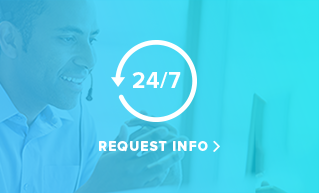
In a time not so long ago, a customer service desk was the only option for voicing your frustrations with a company. You stood in line, chatted face to face with an employee, and if things really needed escalating, you might speak with a manager. Compare that kind of interaction with all the ways customers can seek help now.
We know why customer service strategies are so integral to a business’s success. To go deeper, we need to examine exactly how those strategies are impacted by the multiple channels available to customers in the modern age. Whether you’re chatting with customers over the phone, via email or responding to social media posts, it’s crucial to examine how these platforms differ. To ensure you’re offering both quality products and stellar service, develop a multi-channel customer service strategy. Here’s what you need to know:
Synchronous Customer Service Channels
Live conversations happening in real time define synchronous customer service. Live chats, phone calls and face to face interactions all embody synchronous service. The advantage of such channels are clear: customers can present an issue to an employee and have it resolved on the spot. A two-way conversation can happen with zero delays, which means resolutions are found more quickly and conveniently. This style of one-on-one communication helps reassure customers that their problems matter and that your company is listening.
That doesn’t mean there aren’t downsides to synchronous customer service channels, though. For every positive, personal experience you have with a customer via synchronous channels, there are often dozens of others in line behind them. When call volume is high, your customers may spend precious minutes waiting for their turn to talk to a representative. This can annoy callers who are already frustrated with your service. Callback systems can help mitigate this kind of challenge. Instead of having customers wait on hold for their call to be answered, they can opt to be called back. However, callers dial your number because they want to talk to right then. So a callback can also be inconvenient since the customer has no way of knowing when that’s going to happen.
More problems can arise when a company fails to offer 24-hour service. If your business does not offer round the clock customer service, your clients may feel left out to dry. This puts customers in an awkward situation with no immediate resolution to their problem. In an increasingly global society, leaving phones to ring off the hook after business hours just isn’t an option. Frustrated customers will turn to your competitors the next time they need help instead of waiting for your staff respond.
Asynchronous Customer Service Channels
Convenience is the number one perk of asynchronous customer service channels. Emails, text messages, social media, and direct mailing all meet your customers where they are at. A customer never needs to worry about your hours if you offer asynchronous methods of communication. Those with questions or concerns can dash off a message regardless of what time it is. Customers also need not wait for an agent to answer their phone or sit in a line to speak to someone behind a counter. Instead, they have the luxury of sending you their message at their leisure.
This kind of customer service channel can be hugely beneficial for business. Without tons of calls coming through your phone line, there’s no need to staff more employees to handle the large volume. Agents can instead work at their own pace to plug away at emails and messages. Without the expectation of an instant reply, your employees will feel less pressure and more confidence in their abilities to problem solve.
Asynchronous customer service channels can also be beneficial when handling image files. A customer can opt to send in a screenshot of an error message they received, or attach a photo of their defective product. This works both ways – agents can send back instruction manuals or guides to help solve common issues.
There are downsides to this kind of customer service channel, though. The lack of fast responses can frustrate customers who need help immediately. Not everyone is good at explaining their concerns via text, either. Tone can be difficult to track in such messages, making it tough to solve problems. A lot can get lost in translation, even if you’re speaking the same language.
The Right Channel for Your Business
Take time to assess the customer communication channels available for your company. Each method has its positives and negatives, so you’ll need to decide which ones work best for you and your customer. We recommend incorporating both synchronous and asynchronous channels into your customer service strategy so that customers can choose the form of communication they prefer most.
It’s the best way to keep customers satisfied in their moments of need. Using both types of channels can make customer service more efficient. A call center or live chat can offer customers the immediate support they need, while an email or social media message allows users to connect on their terms. Both options offer wraparound customer support. Customers will always be able to contact you when they need to. This sends a powerful message: you care about your customers and you’re eager to keep them happy.
They say you can’t please everyone, but multi-channel customer service strategies strive to do just that. Combine the channels that make the most sense for your business, and you’ll be ready to tackle any customer service challenge that comes your way.
The Right Partner for Your Customer Service Channels
The perfect combination of customer service channels will be worthless without quality employees to staff them. For all the perks that synchronous and asynchronous channels offer, they are inadequate if they’re not operated by experienced and highly-trained representatives. Whether you’re hoping to handle all customer service communication via email and live chat or prefer to operate over the phone, the right employee can make all the difference. Fail to find the right fit and it won’t matter how efficient your channels are – customers will be frustrated by the human behind the screen or at the end of the line.
The takeaway? Your customer service strategy should always hinge on quality people with a dedication to service. They’ll be your secret weapon, regardless of which kind of customer service channels you opt to use.
Additional chapters in our Customer Service guide:
Chapter 1: Setting A Winning Strategy


